Detailed Holistic Patient Assessment for Diabetes Mellitus Management
VerifiedAdded on 2022/12/27
|12
|2287
|1
Essay
AI Summary
This essay provides a comprehensive holistic assessment of a 65-year-old patient, Lily Blossom, diagnosed with type-2 diabetes, osteoarthritis, and obesity. The assessment encompasses health history, physiological, psychological, social, cultural, developmental, and spiritual evaluations. The essay details the patient's condition, including elevated blood glucose levels, joint pain, depression, social withdrawal, and adherence to cultural traditions. Interpretation of findings highlights the impact of diabetes on the patient's life, including challenges with dietary modifications, self-monitoring, and potential complications. A teaching plan is proposed to address physical, psychological, social, cultural, developmental, and spiritual needs, aiming to improve the patient's quality of life through education, support, and behavioral modifications. The essay emphasizes the importance of holistic care, addressing the patient's mind, body, and soul.
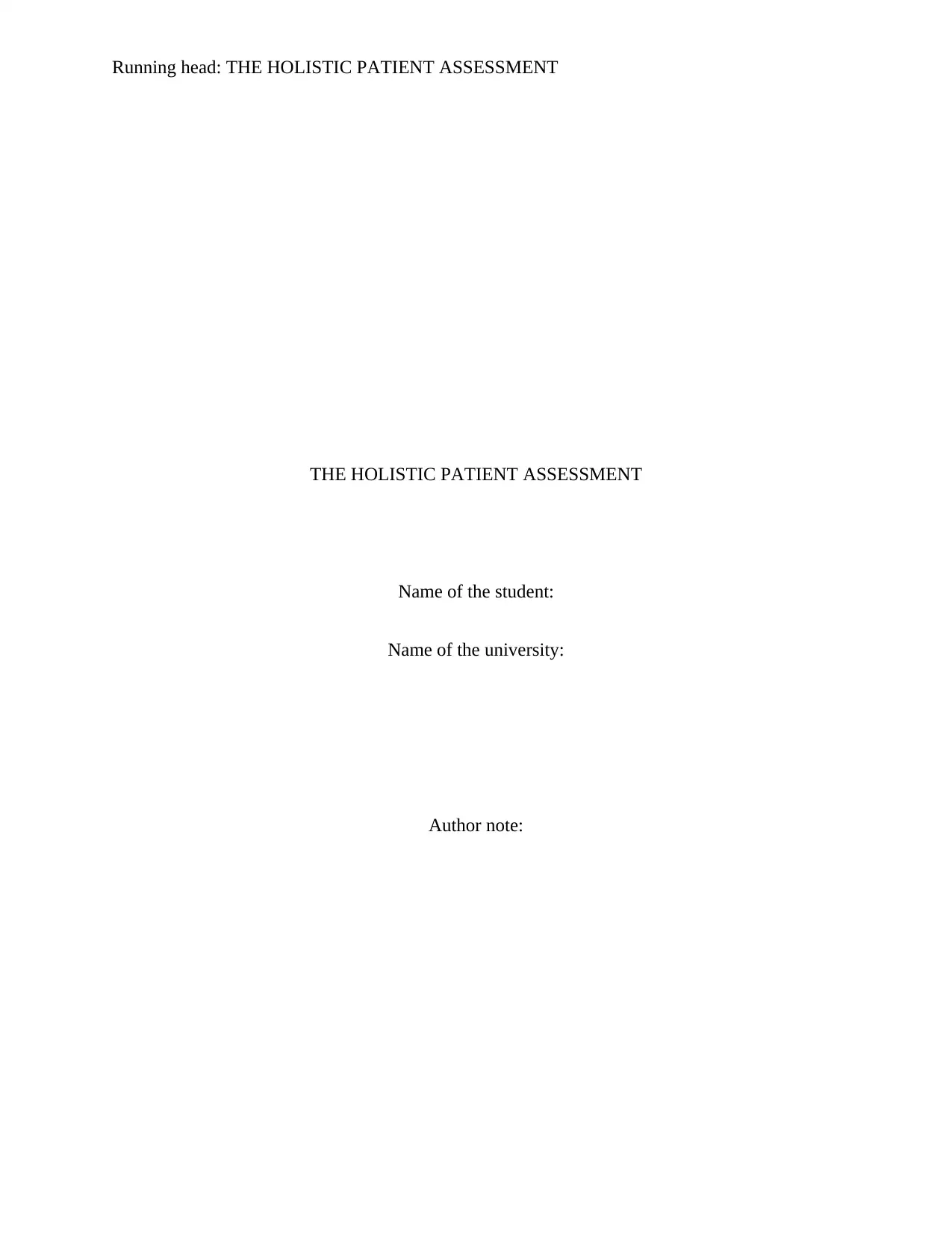
Running head: THE HOLISTIC PATIENT ASSESSMENT
THE HOLISTIC PATIENT ASSESSMENT
Name of the student:
Name of the university:
Author note:
THE HOLISTIC PATIENT ASSESSMENT
Name of the student:
Name of the university:
Author note:
Paraphrase This Document
Need a fresh take? Get an instant paraphrase of this document with our AI Paraphraser
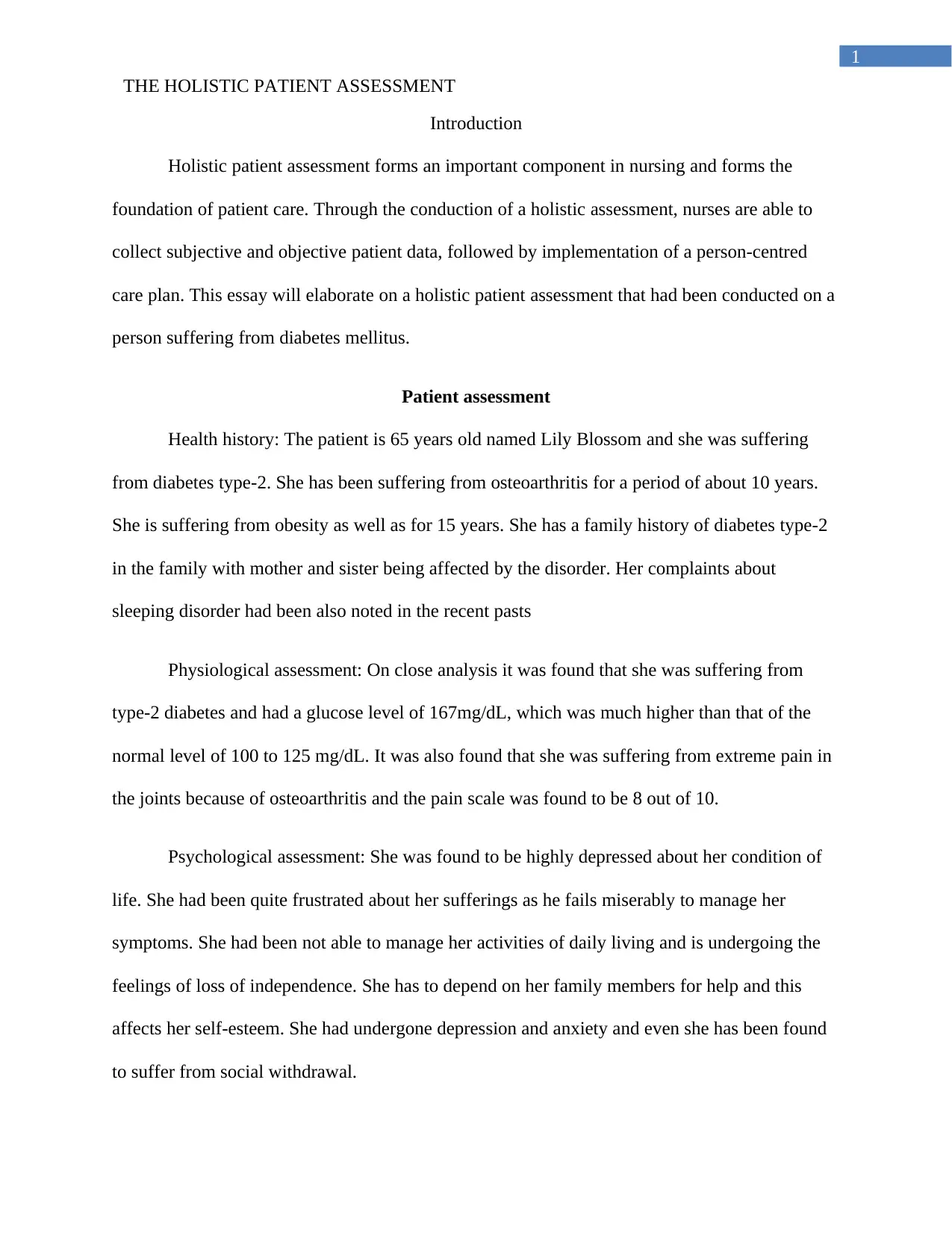
1
THE HOLISTIC PATIENT ASSESSMENT
Introduction
Holistic patient assessment forms an important component in nursing and forms the
foundation of patient care. Through the conduction of a holistic assessment, nurses are able to
collect subjective and objective patient data, followed by implementation of a person-centred
care plan. This essay will elaborate on a holistic patient assessment that had been conducted on a
person suffering from diabetes mellitus.
Patient assessment
Health history: The patient is 65 years old named Lily Blossom and she was suffering
from diabetes type-2. She has been suffering from osteoarthritis for a period of about 10 years.
She is suffering from obesity as well as for 15 years. She has a family history of diabetes type-2
in the family with mother and sister being affected by the disorder. Her complaints about
sleeping disorder had been also noted in the recent pasts
Physiological assessment: On close analysis it was found that she was suffering from
type-2 diabetes and had a glucose level of 167mg/dL, which was much higher than that of the
normal level of 100 to 125 mg/dL. It was also found that she was suffering from extreme pain in
the joints because of osteoarthritis and the pain scale was found to be 8 out of 10.
Psychological assessment: She was found to be highly depressed about her condition of
life. She had been quite frustrated about her sufferings as he fails miserably to manage her
symptoms. She had been not able to manage her activities of daily living and is undergoing the
feelings of loss of independence. She has to depend on her family members for help and this
affects her self-esteem. She had undergone depression and anxiety and even she has been found
to suffer from social withdrawal.
THE HOLISTIC PATIENT ASSESSMENT
Introduction
Holistic patient assessment forms an important component in nursing and forms the
foundation of patient care. Through the conduction of a holistic assessment, nurses are able to
collect subjective and objective patient data, followed by implementation of a person-centred
care plan. This essay will elaborate on a holistic patient assessment that had been conducted on a
person suffering from diabetes mellitus.
Patient assessment
Health history: The patient is 65 years old named Lily Blossom and she was suffering
from diabetes type-2. She has been suffering from osteoarthritis for a period of about 10 years.
She is suffering from obesity as well as for 15 years. She has a family history of diabetes type-2
in the family with mother and sister being affected by the disorder. Her complaints about
sleeping disorder had been also noted in the recent pasts
Physiological assessment: On close analysis it was found that she was suffering from
type-2 diabetes and had a glucose level of 167mg/dL, which was much higher than that of the
normal level of 100 to 125 mg/dL. It was also found that she was suffering from extreme pain in
the joints because of osteoarthritis and the pain scale was found to be 8 out of 10.
Psychological assessment: She was found to be highly depressed about her condition of
life. She had been quite frustrated about her sufferings as he fails miserably to manage her
symptoms. She had been not able to manage her activities of daily living and is undergoing the
feelings of loss of independence. She has to depend on her family members for help and this
affects her self-esteem. She had undergone depression and anxiety and even she has been found
to suffer from social withdrawal.
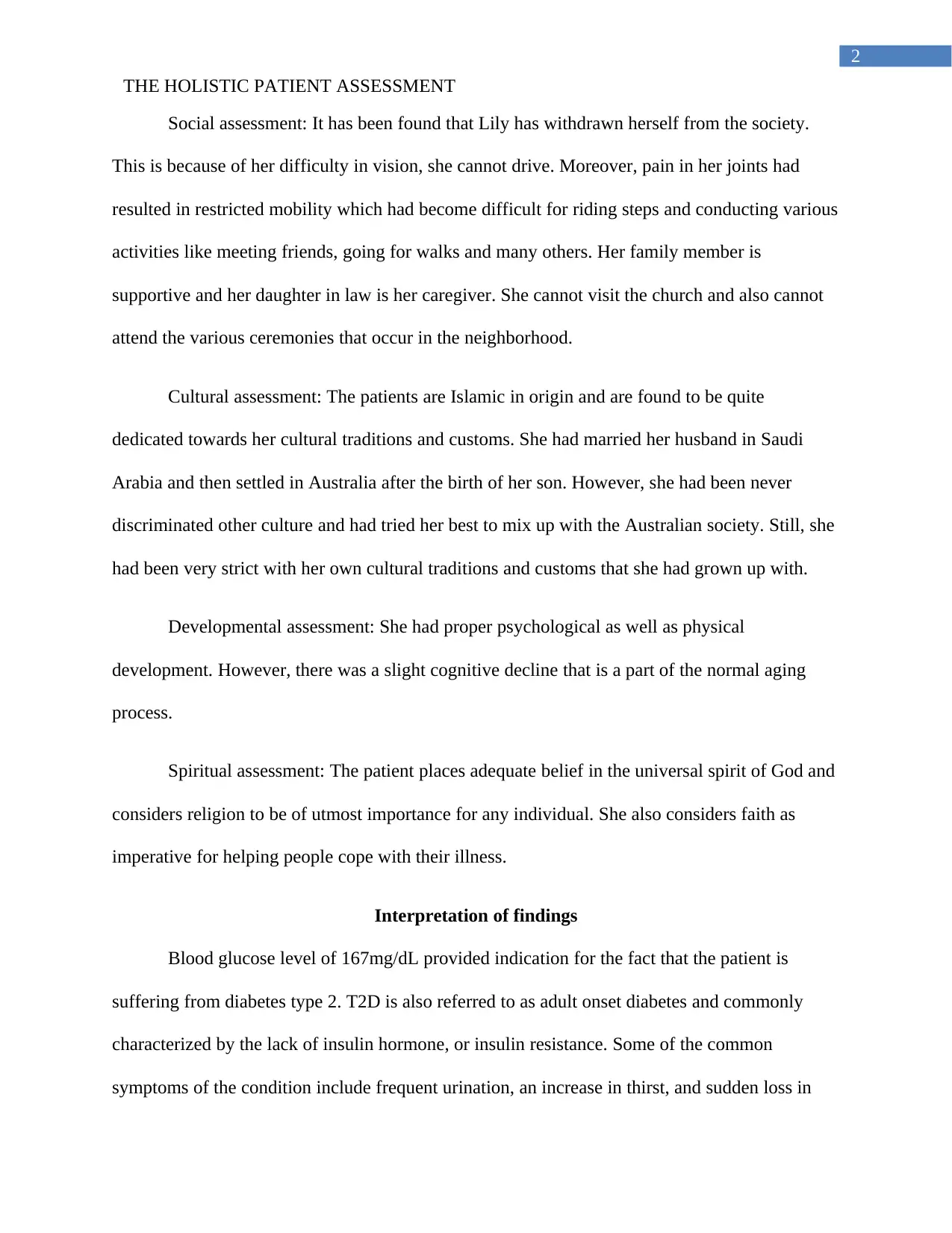
2
THE HOLISTIC PATIENT ASSESSMENT
Social assessment: It has been found that Lily has withdrawn herself from the society.
This is because of her difficulty in vision, she cannot drive. Moreover, pain in her joints had
resulted in restricted mobility which had become difficult for riding steps and conducting various
activities like meeting friends, going for walks and many others. Her family member is
supportive and her daughter in law is her caregiver. She cannot visit the church and also cannot
attend the various ceremonies that occur in the neighborhood.
Cultural assessment: The patients are Islamic in origin and are found to be quite
dedicated towards her cultural traditions and customs. She had married her husband in Saudi
Arabia and then settled in Australia after the birth of her son. However, she had been never
discriminated other culture and had tried her best to mix up with the Australian society. Still, she
had been very strict with her own cultural traditions and customs that she had grown up with.
Developmental assessment: She had proper psychological as well as physical
development. However, there was a slight cognitive decline that is a part of the normal aging
process.
Spiritual assessment: The patient places adequate belief in the universal spirit of God and
considers religion to be of utmost importance for any individual. She also considers faith as
imperative for helping people cope with their illness.
Interpretation of findings
Blood glucose level of 167mg/dL provided indication for the fact that the patient is
suffering from diabetes type 2. T2D is also referred to as adult onset diabetes and commonly
characterized by the lack of insulin hormone, or insulin resistance. Some of the common
symptoms of the condition include frequent urination, an increase in thirst, and sudden loss in
THE HOLISTIC PATIENT ASSESSMENT
Social assessment: It has been found that Lily has withdrawn herself from the society.
This is because of her difficulty in vision, she cannot drive. Moreover, pain in her joints had
resulted in restricted mobility which had become difficult for riding steps and conducting various
activities like meeting friends, going for walks and many others. Her family member is
supportive and her daughter in law is her caregiver. She cannot visit the church and also cannot
attend the various ceremonies that occur in the neighborhood.
Cultural assessment: The patients are Islamic in origin and are found to be quite
dedicated towards her cultural traditions and customs. She had married her husband in Saudi
Arabia and then settled in Australia after the birth of her son. However, she had been never
discriminated other culture and had tried her best to mix up with the Australian society. Still, she
had been very strict with her own cultural traditions and customs that she had grown up with.
Developmental assessment: She had proper psychological as well as physical
development. However, there was a slight cognitive decline that is a part of the normal aging
process.
Spiritual assessment: The patient places adequate belief in the universal spirit of God and
considers religion to be of utmost importance for any individual. She also considers faith as
imperative for helping people cope with their illness.
Interpretation of findings
Blood glucose level of 167mg/dL provided indication for the fact that the patient is
suffering from diabetes type 2. T2D is also referred to as adult onset diabetes and commonly
characterized by the lack of insulin hormone, or insulin resistance. Some of the common
symptoms of the condition include frequent urination, an increase in thirst, and sudden loss in
⊘ This is a preview!⊘
Do you want full access?
Subscribe today to unlock all pages.

Trusted by 1+ million students worldwide
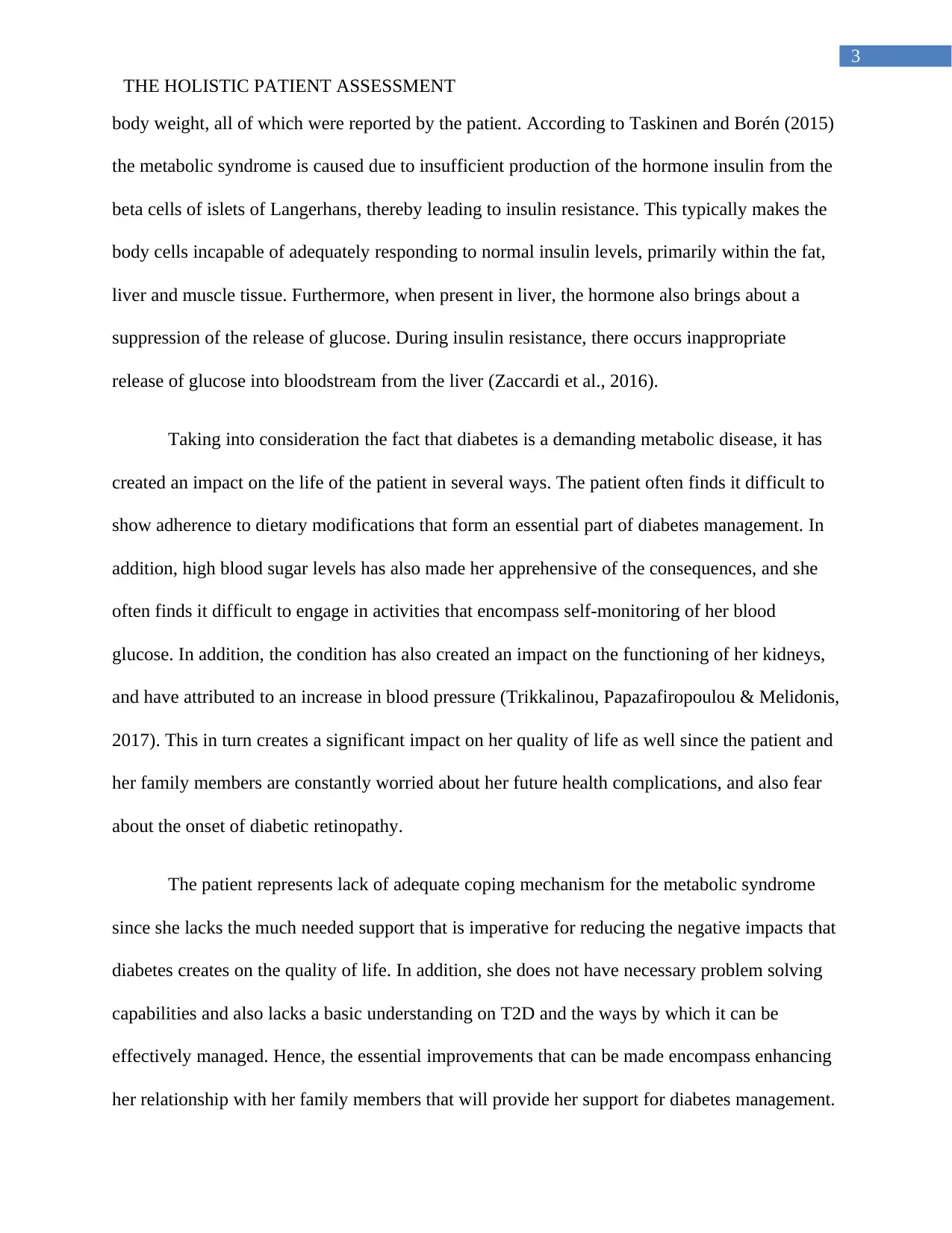
3
THE HOLISTIC PATIENT ASSESSMENT
body weight, all of which were reported by the patient. According to Taskinen and Borén (2015)
the metabolic syndrome is caused due to insufficient production of the hormone insulin from the
beta cells of islets of Langerhans, thereby leading to insulin resistance. This typically makes the
body cells incapable of adequately responding to normal insulin levels, primarily within the fat,
liver and muscle tissue. Furthermore, when present in liver, the hormone also brings about a
suppression of the release of glucose. During insulin resistance, there occurs inappropriate
release of glucose into bloodstream from the liver (Zaccardi et al., 2016).
Taking into consideration the fact that diabetes is a demanding metabolic disease, it has
created an impact on the life of the patient in several ways. The patient often finds it difficult to
show adherence to dietary modifications that form an essential part of diabetes management. In
addition, high blood sugar levels has also made her apprehensive of the consequences, and she
often finds it difficult to engage in activities that encompass self-monitoring of her blood
glucose. In addition, the condition has also created an impact on the functioning of her kidneys,
and have attributed to an increase in blood pressure (Trikkalinou, Papazafiropoulou & Melidonis,
2017). This in turn creates a significant impact on her quality of life as well since the patient and
her family members are constantly worried about her future health complications, and also fear
about the onset of diabetic retinopathy.
The patient represents lack of adequate coping mechanism for the metabolic syndrome
since she lacks the much needed support that is imperative for reducing the negative impacts that
diabetes creates on the quality of life. In addition, she does not have necessary problem solving
capabilities and also lacks a basic understanding on T2D and the ways by which it can be
effectively managed. Hence, the essential improvements that can be made encompass enhancing
her relationship with her family members that will provide her support for diabetes management.
THE HOLISTIC PATIENT ASSESSMENT
body weight, all of which were reported by the patient. According to Taskinen and Borén (2015)
the metabolic syndrome is caused due to insufficient production of the hormone insulin from the
beta cells of islets of Langerhans, thereby leading to insulin resistance. This typically makes the
body cells incapable of adequately responding to normal insulin levels, primarily within the fat,
liver and muscle tissue. Furthermore, when present in liver, the hormone also brings about a
suppression of the release of glucose. During insulin resistance, there occurs inappropriate
release of glucose into bloodstream from the liver (Zaccardi et al., 2016).
Taking into consideration the fact that diabetes is a demanding metabolic disease, it has
created an impact on the life of the patient in several ways. The patient often finds it difficult to
show adherence to dietary modifications that form an essential part of diabetes management. In
addition, high blood sugar levels has also made her apprehensive of the consequences, and she
often finds it difficult to engage in activities that encompass self-monitoring of her blood
glucose. In addition, the condition has also created an impact on the functioning of her kidneys,
and have attributed to an increase in blood pressure (Trikkalinou, Papazafiropoulou & Melidonis,
2017). This in turn creates a significant impact on her quality of life as well since the patient and
her family members are constantly worried about her future health complications, and also fear
about the onset of diabetic retinopathy.
The patient represents lack of adequate coping mechanism for the metabolic syndrome
since she lacks the much needed support that is imperative for reducing the negative impacts that
diabetes creates on the quality of life. In addition, she does not have necessary problem solving
capabilities and also lacks a basic understanding on T2D and the ways by which it can be
effectively managed. Hence, the essential improvements that can be made encompass enhancing
her relationship with her family members that will provide her support for diabetes management.
Paraphrase This Document
Need a fresh take? Get an instant paraphrase of this document with our AI Paraphraser
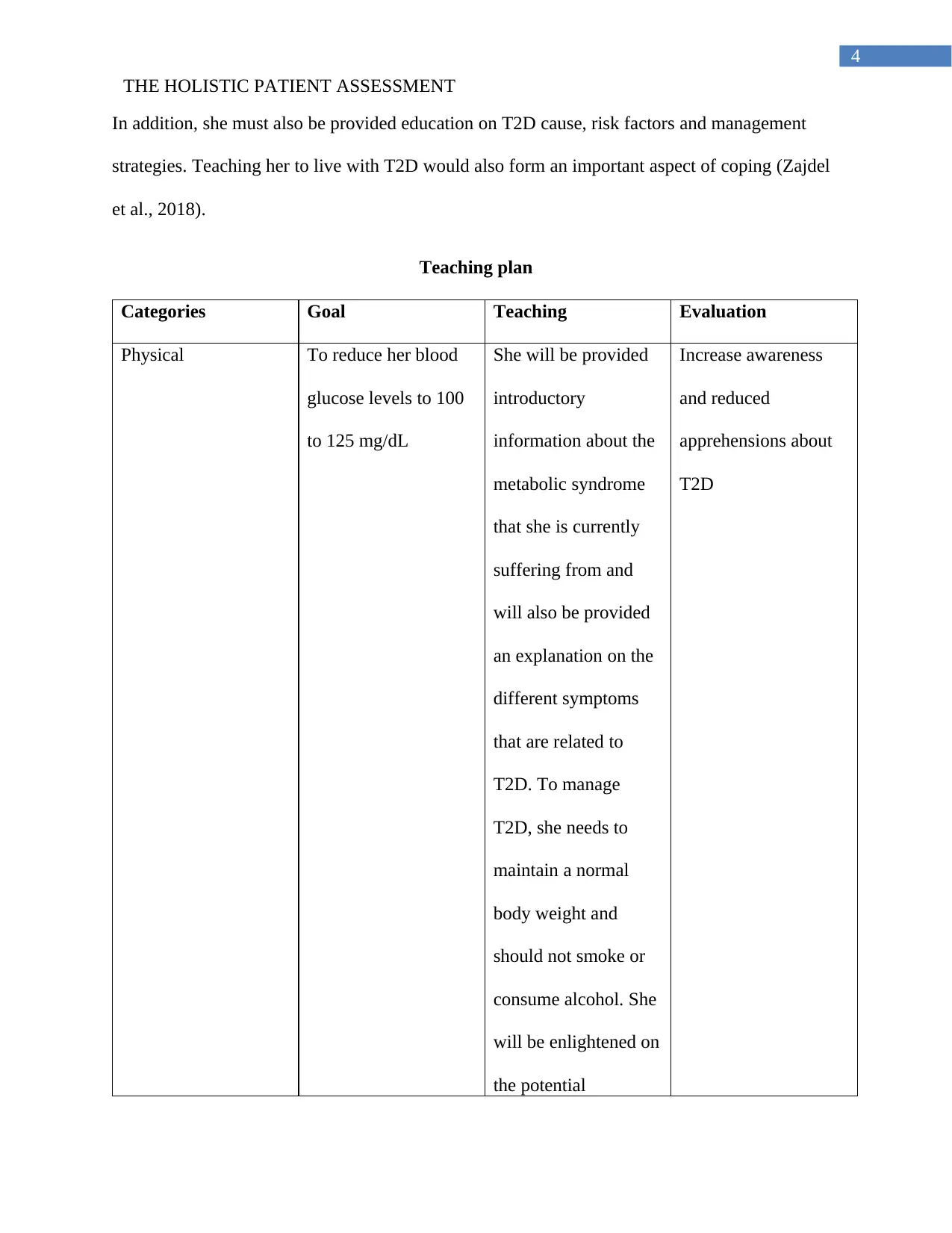
4
THE HOLISTIC PATIENT ASSESSMENT
In addition, she must also be provided education on T2D cause, risk factors and management
strategies. Teaching her to live with T2D would also form an important aspect of coping (Zajdel
et al., 2018).
Teaching plan
Categories Goal Teaching Evaluation
Physical To reduce her blood
glucose levels to 100
to 125 mg/dL
She will be provided
introductory
information about the
metabolic syndrome
that she is currently
suffering from and
will also be provided
an explanation on the
different symptoms
that are related to
T2D. To manage
T2D, she needs to
maintain a normal
body weight and
should not smoke or
consume alcohol. She
will be enlightened on
the potential
Increase awareness
and reduced
apprehensions about
T2D
THE HOLISTIC PATIENT ASSESSMENT
In addition, she must also be provided education on T2D cause, risk factors and management
strategies. Teaching her to live with T2D would also form an important aspect of coping (Zajdel
et al., 2018).
Teaching plan
Categories Goal Teaching Evaluation
Physical To reduce her blood
glucose levels to 100
to 125 mg/dL
She will be provided
introductory
information about the
metabolic syndrome
that she is currently
suffering from and
will also be provided
an explanation on the
different symptoms
that are related to
T2D. To manage
T2D, she needs to
maintain a normal
body weight and
should not smoke or
consume alcohol. She
will be enlightened on
the potential
Increase awareness
and reduced
apprehensions about
T2D
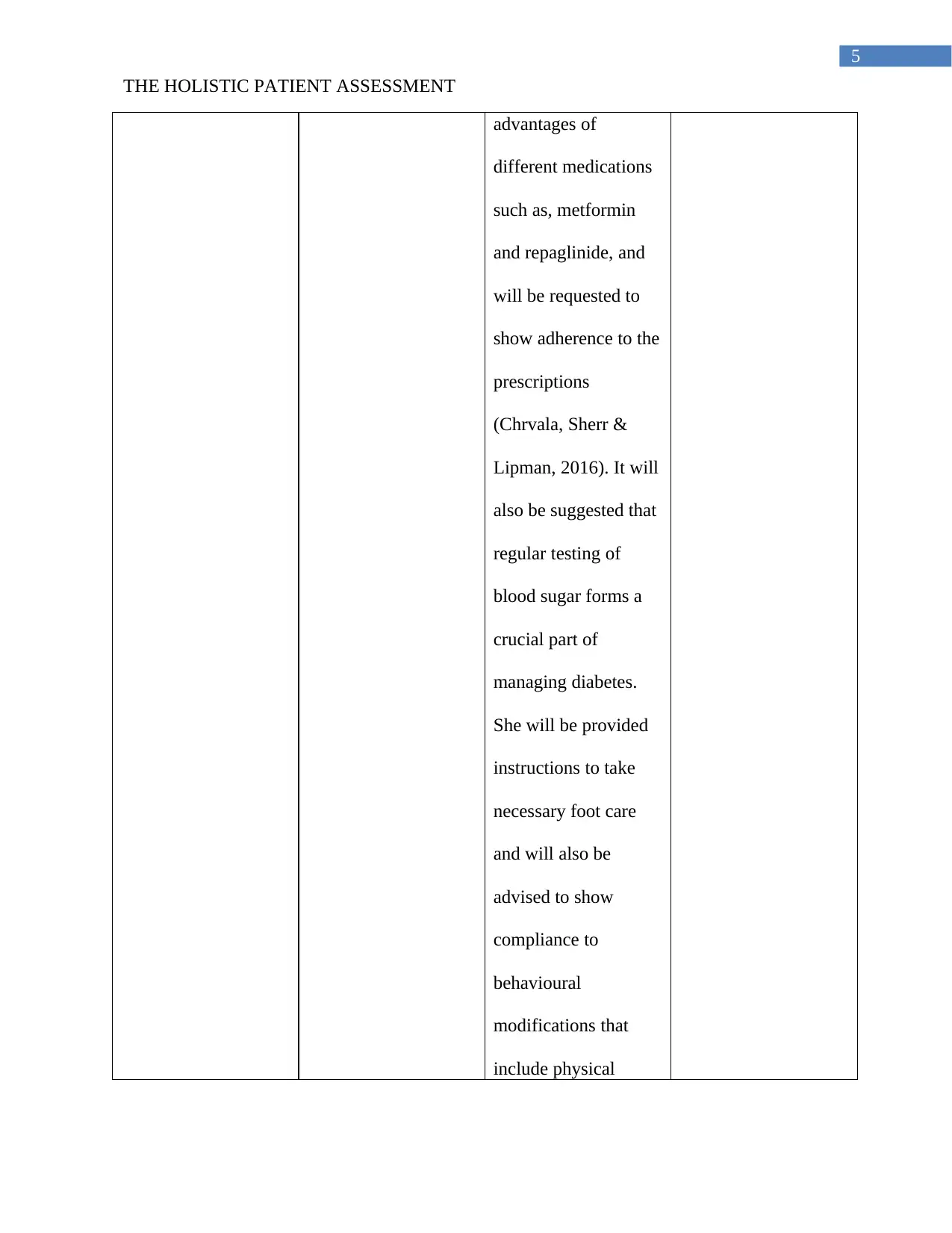
5
THE HOLISTIC PATIENT ASSESSMENT
advantages of
different medications
such as, metformin
and repaglinide, and
will be requested to
show adherence to the
prescriptions
(Chrvala, Sherr &
Lipman, 2016). It will
also be suggested that
regular testing of
blood sugar forms a
crucial part of
managing diabetes.
She will be provided
instructions to take
necessary foot care
and will also be
advised to show
compliance to
behavioural
modifications that
include physical
THE HOLISTIC PATIENT ASSESSMENT
advantages of
different medications
such as, metformin
and repaglinide, and
will be requested to
show adherence to the
prescriptions
(Chrvala, Sherr &
Lipman, 2016). It will
also be suggested that
regular testing of
blood sugar forms a
crucial part of
managing diabetes.
She will be provided
instructions to take
necessary foot care
and will also be
advised to show
compliance to
behavioural
modifications that
include physical
⊘ This is a preview!⊘
Do you want full access?
Subscribe today to unlock all pages.

Trusted by 1+ million students worldwide
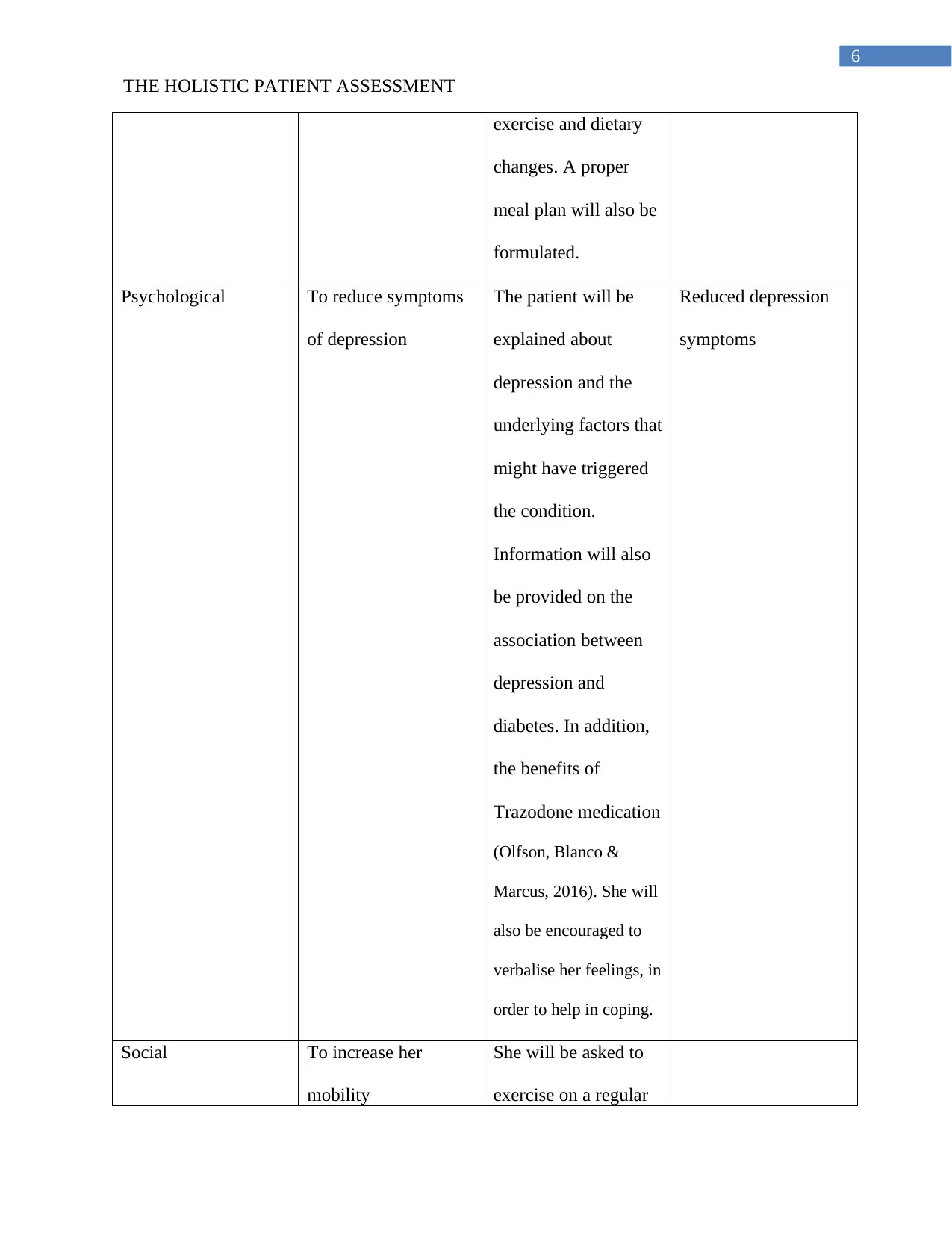
6
THE HOLISTIC PATIENT ASSESSMENT
exercise and dietary
changes. A proper
meal plan will also be
formulated.
Psychological To reduce symptoms
of depression
The patient will be
explained about
depression and the
underlying factors that
might have triggered
the condition.
Information will also
be provided on the
association between
depression and
diabetes. In addition,
the benefits of
Trazodone medication
(Olfson, Blanco &
Marcus, 2016). She will
also be encouraged to
verbalise her feelings, in
order to help in coping.
Reduced depression
symptoms
Social To increase her
mobility
She will be asked to
exercise on a regular
THE HOLISTIC PATIENT ASSESSMENT
exercise and dietary
changes. A proper
meal plan will also be
formulated.
Psychological To reduce symptoms
of depression
The patient will be
explained about
depression and the
underlying factors that
might have triggered
the condition.
Information will also
be provided on the
association between
depression and
diabetes. In addition,
the benefits of
Trazodone medication
(Olfson, Blanco &
Marcus, 2016). She will
also be encouraged to
verbalise her feelings, in
order to help in coping.
Reduced depression
symptoms
Social To increase her
mobility
She will be asked to
exercise on a regular
Paraphrase This Document
Need a fresh take? Get an instant paraphrase of this document with our AI Paraphraser
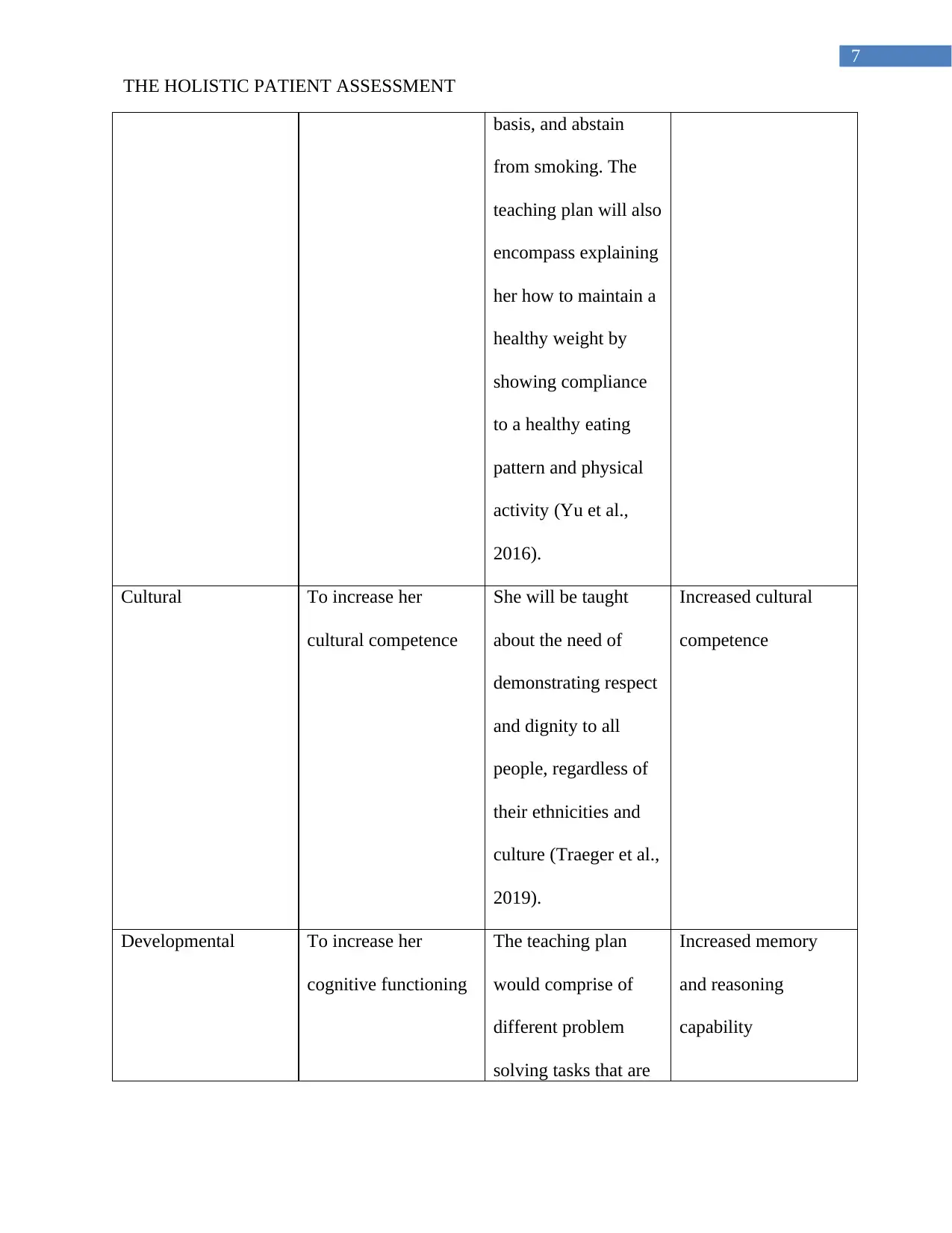
7
THE HOLISTIC PATIENT ASSESSMENT
basis, and abstain
from smoking. The
teaching plan will also
encompass explaining
her how to maintain a
healthy weight by
showing compliance
to a healthy eating
pattern and physical
activity (Yu et al.,
2016).
Cultural To increase her
cultural competence
She will be taught
about the need of
demonstrating respect
and dignity to all
people, regardless of
their ethnicities and
culture (Traeger et al.,
2019).
Increased cultural
competence
Developmental To increase her
cognitive functioning
The teaching plan
would comprise of
different problem
solving tasks that are
Increased memory
and reasoning
capability
THE HOLISTIC PATIENT ASSESSMENT
basis, and abstain
from smoking. The
teaching plan will also
encompass explaining
her how to maintain a
healthy weight by
showing compliance
to a healthy eating
pattern and physical
activity (Yu et al.,
2016).
Cultural To increase her
cultural competence
She will be taught
about the need of
demonstrating respect
and dignity to all
people, regardless of
their ethnicities and
culture (Traeger et al.,
2019).
Increased cultural
competence
Developmental To increase her
cognitive functioning
The teaching plan
would comprise of
different problem
solving tasks that are
Increased memory
and reasoning
capability
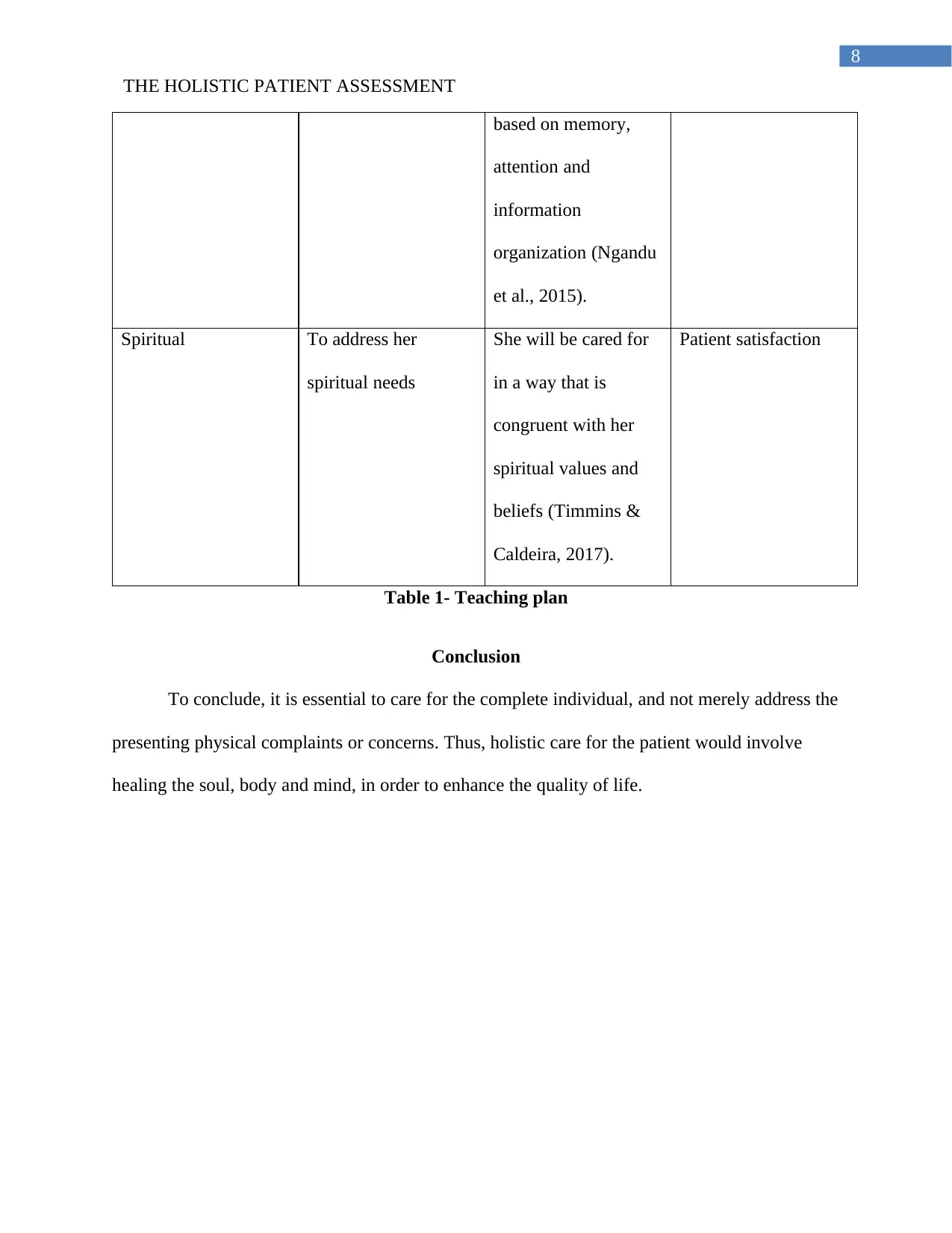
8
THE HOLISTIC PATIENT ASSESSMENT
based on memory,
attention and
information
organization (Ngandu
et al., 2015).
Spiritual To address her
spiritual needs
She will be cared for
in a way that is
congruent with her
spiritual values and
beliefs (Timmins &
Caldeira, 2017).
Patient satisfaction
Table 1- Teaching plan
Conclusion
To conclude, it is essential to care for the complete individual, and not merely address the
presenting physical complaints or concerns. Thus, holistic care for the patient would involve
healing the soul, body and mind, in order to enhance the quality of life.
THE HOLISTIC PATIENT ASSESSMENT
based on memory,
attention and
information
organization (Ngandu
et al., 2015).
Spiritual To address her
spiritual needs
She will be cared for
in a way that is
congruent with her
spiritual values and
beliefs (Timmins &
Caldeira, 2017).
Patient satisfaction
Table 1- Teaching plan
Conclusion
To conclude, it is essential to care for the complete individual, and not merely address the
presenting physical complaints or concerns. Thus, holistic care for the patient would involve
healing the soul, body and mind, in order to enhance the quality of life.
⊘ This is a preview!⊘
Do you want full access?
Subscribe today to unlock all pages.

Trusted by 1+ million students worldwide
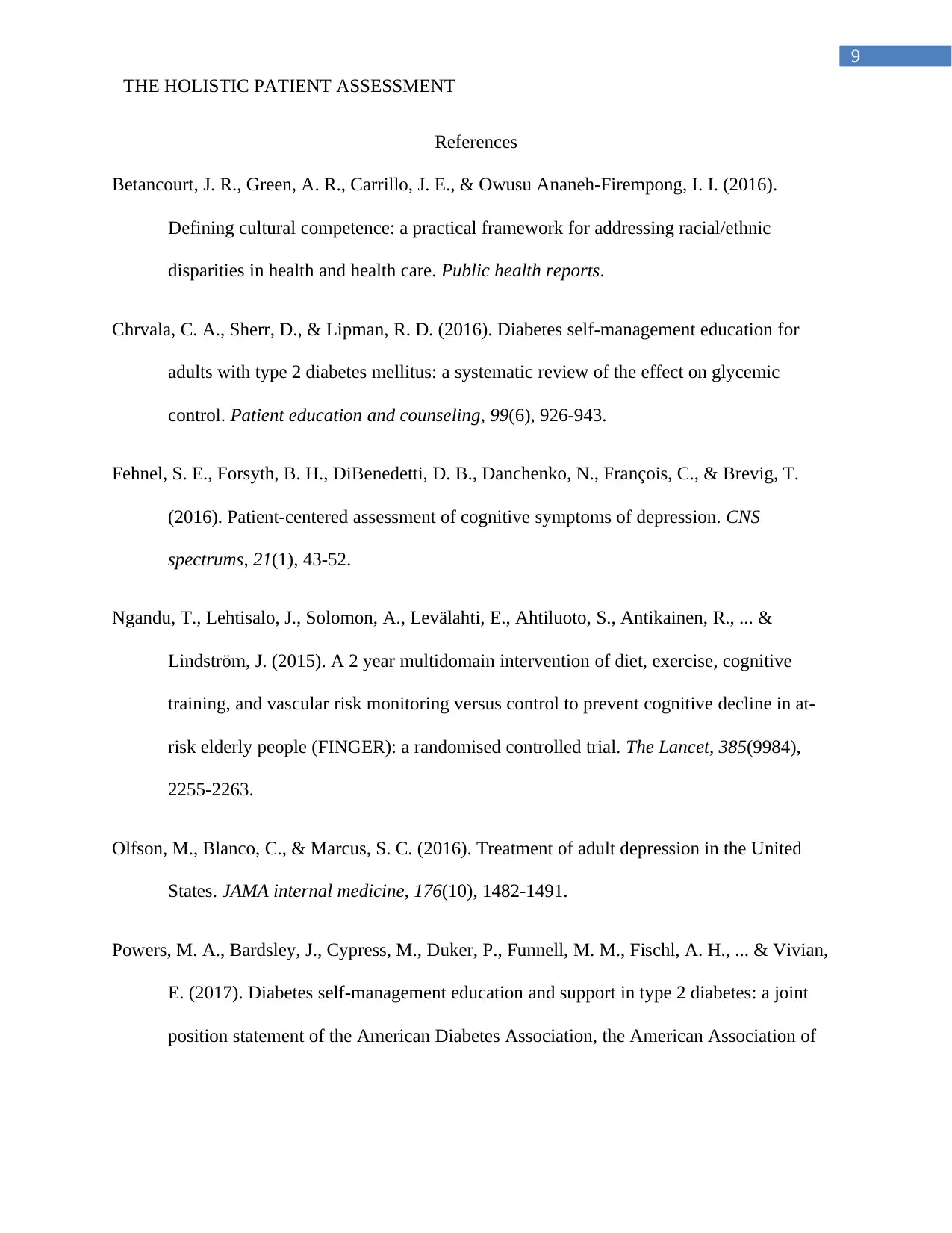
9
THE HOLISTIC PATIENT ASSESSMENT
References
Betancourt, J. R., Green, A. R., Carrillo, J. E., & Owusu Ananeh-Firempong, I. I. (2016).
Defining cultural competence: a practical framework for addressing racial/ethnic
disparities in health and health care. Public health reports.
Chrvala, C. A., Sherr, D., & Lipman, R. D. (2016). Diabetes self-management education for
adults with type 2 diabetes mellitus: a systematic review of the effect on glycemic
control. Patient education and counseling, 99(6), 926-943.
Fehnel, S. E., Forsyth, B. H., DiBenedetti, D. B., Danchenko, N., François, C., & Brevig, T.
(2016). Patient-centered assessment of cognitive symptoms of depression. CNS
spectrums, 21(1), 43-52.
Ngandu, T., Lehtisalo, J., Solomon, A., Levälahti, E., Ahtiluoto, S., Antikainen, R., ... &
Lindström, J. (2015). A 2 year multidomain intervention of diet, exercise, cognitive
training, and vascular risk monitoring versus control to prevent cognitive decline in at-
risk elderly people (FINGER): a randomised controlled trial. The Lancet, 385(9984),
2255-2263.
Olfson, M., Blanco, C., & Marcus, S. C. (2016). Treatment of adult depression in the United
States. JAMA internal medicine, 176(10), 1482-1491.
Powers, M. A., Bardsley, J., Cypress, M., Duker, P., Funnell, M. M., Fischl, A. H., ... & Vivian,
E. (2017). Diabetes self-management education and support in type 2 diabetes: a joint
position statement of the American Diabetes Association, the American Association of
THE HOLISTIC PATIENT ASSESSMENT
References
Betancourt, J. R., Green, A. R., Carrillo, J. E., & Owusu Ananeh-Firempong, I. I. (2016).
Defining cultural competence: a practical framework for addressing racial/ethnic
disparities in health and health care. Public health reports.
Chrvala, C. A., Sherr, D., & Lipman, R. D. (2016). Diabetes self-management education for
adults with type 2 diabetes mellitus: a systematic review of the effect on glycemic
control. Patient education and counseling, 99(6), 926-943.
Fehnel, S. E., Forsyth, B. H., DiBenedetti, D. B., Danchenko, N., François, C., & Brevig, T.
(2016). Patient-centered assessment of cognitive symptoms of depression. CNS
spectrums, 21(1), 43-52.
Ngandu, T., Lehtisalo, J., Solomon, A., Levälahti, E., Ahtiluoto, S., Antikainen, R., ... &
Lindström, J. (2015). A 2 year multidomain intervention of diet, exercise, cognitive
training, and vascular risk monitoring versus control to prevent cognitive decline in at-
risk elderly people (FINGER): a randomised controlled trial. The Lancet, 385(9984),
2255-2263.
Olfson, M., Blanco, C., & Marcus, S. C. (2016). Treatment of adult depression in the United
States. JAMA internal medicine, 176(10), 1482-1491.
Powers, M. A., Bardsley, J., Cypress, M., Duker, P., Funnell, M. M., Fischl, A. H., ... & Vivian,
E. (2017). Diabetes self-management education and support in type 2 diabetes: a joint
position statement of the American Diabetes Association, the American Association of
Paraphrase This Document
Need a fresh take? Get an instant paraphrase of this document with our AI Paraphraser
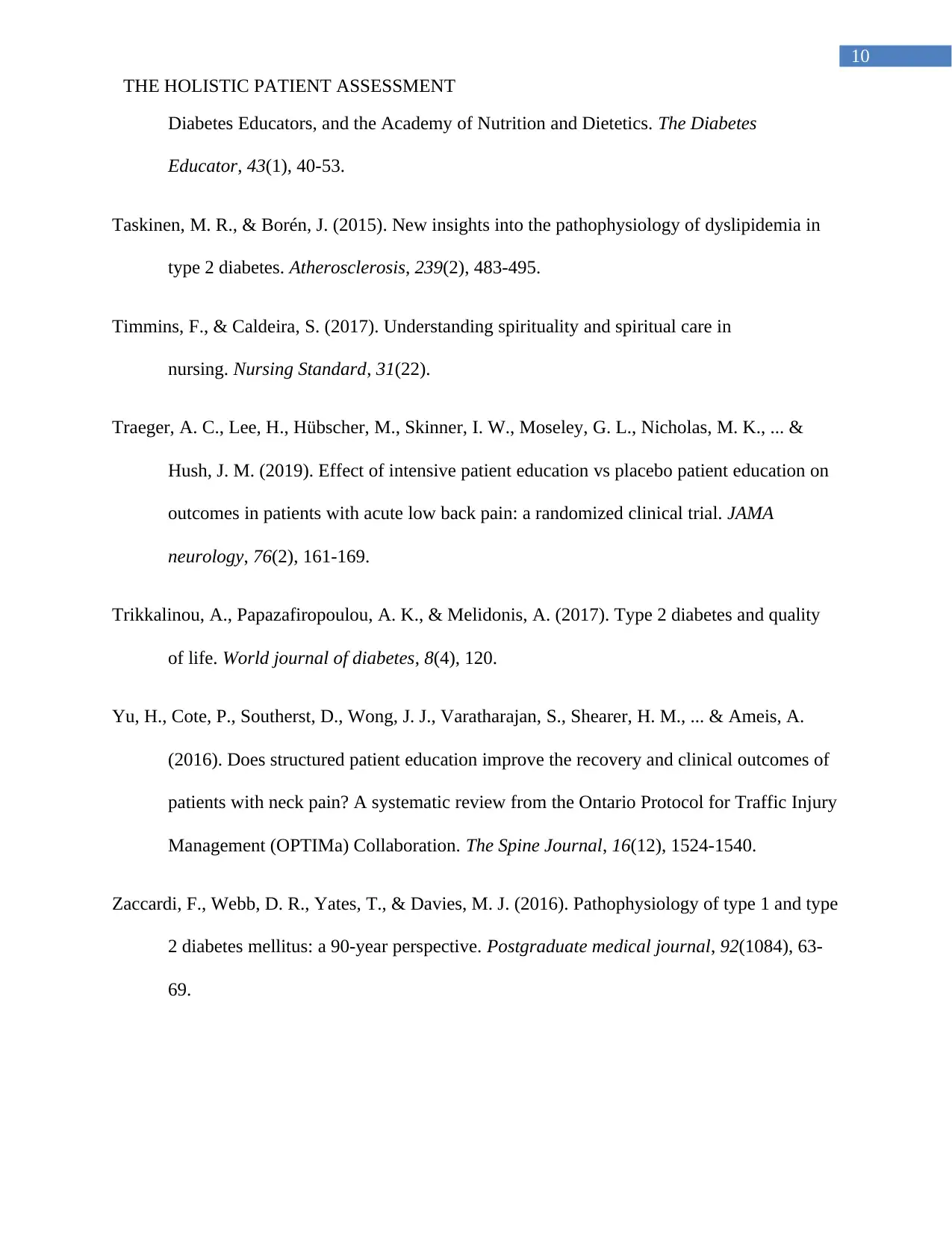
10
THE HOLISTIC PATIENT ASSESSMENT
Diabetes Educators, and the Academy of Nutrition and Dietetics. The Diabetes
Educator, 43(1), 40-53.
Taskinen, M. R., & Borén, J. (2015). New insights into the pathophysiology of dyslipidemia in
type 2 diabetes. Atherosclerosis, 239(2), 483-495.
Timmins, F., & Caldeira, S. (2017). Understanding spirituality and spiritual care in
nursing. Nursing Standard, 31(22).
Traeger, A. C., Lee, H., Hübscher, M., Skinner, I. W., Moseley, G. L., Nicholas, M. K., ... &
Hush, J. M. (2019). Effect of intensive patient education vs placebo patient education on
outcomes in patients with acute low back pain: a randomized clinical trial. JAMA
neurology, 76(2), 161-169.
Trikkalinou, A., Papazafiropoulou, A. K., & Melidonis, A. (2017). Type 2 diabetes and quality
of life. World journal of diabetes, 8(4), 120.
Yu, H., Cote, P., Southerst, D., Wong, J. J., Varatharajan, S., Shearer, H. M., ... & Ameis, A.
(2016). Does structured patient education improve the recovery and clinical outcomes of
patients with neck pain? A systematic review from the Ontario Protocol for Traffic Injury
Management (OPTIMa) Collaboration. The Spine Journal, 16(12), 1524-1540.
Zaccardi, F., Webb, D. R., Yates, T., & Davies, M. J. (2016). Pathophysiology of type 1 and type
2 diabetes mellitus: a 90-year perspective. Postgraduate medical journal, 92(1084), 63-
69.
THE HOLISTIC PATIENT ASSESSMENT
Diabetes Educators, and the Academy of Nutrition and Dietetics. The Diabetes
Educator, 43(1), 40-53.
Taskinen, M. R., & Borén, J. (2015). New insights into the pathophysiology of dyslipidemia in
type 2 diabetes. Atherosclerosis, 239(2), 483-495.
Timmins, F., & Caldeira, S. (2017). Understanding spirituality and spiritual care in
nursing. Nursing Standard, 31(22).
Traeger, A. C., Lee, H., Hübscher, M., Skinner, I. W., Moseley, G. L., Nicholas, M. K., ... &
Hush, J. M. (2019). Effect of intensive patient education vs placebo patient education on
outcomes in patients with acute low back pain: a randomized clinical trial. JAMA
neurology, 76(2), 161-169.
Trikkalinou, A., Papazafiropoulou, A. K., & Melidonis, A. (2017). Type 2 diabetes and quality
of life. World journal of diabetes, 8(4), 120.
Yu, H., Cote, P., Southerst, D., Wong, J. J., Varatharajan, S., Shearer, H. M., ... & Ameis, A.
(2016). Does structured patient education improve the recovery and clinical outcomes of
patients with neck pain? A systematic review from the Ontario Protocol for Traffic Injury
Management (OPTIMa) Collaboration. The Spine Journal, 16(12), 1524-1540.
Zaccardi, F., Webb, D. R., Yates, T., & Davies, M. J. (2016). Pathophysiology of type 1 and type
2 diabetes mellitus: a 90-year perspective. Postgraduate medical journal, 92(1084), 63-
69.

11
THE HOLISTIC PATIENT ASSESSMENT
Zajdel, M., Helgeson, V. S., Seltman, H. J., Korytkowski, M. T., & Hausmann, L. R. (2018).
Daily communal coping in couples with type 2 diabetes: links to mood and self-
care. Annals of Behavioral Medicine, 52(3), 228-238.
THE HOLISTIC PATIENT ASSESSMENT
Zajdel, M., Helgeson, V. S., Seltman, H. J., Korytkowski, M. T., & Hausmann, L. R. (2018).
Daily communal coping in couples with type 2 diabetes: links to mood and self-
care. Annals of Behavioral Medicine, 52(3), 228-238.
⊘ This is a preview!⊘
Do you want full access?
Subscribe today to unlock all pages.

Trusted by 1+ million students worldwide
1 out of 12
Related Documents
Your All-in-One AI-Powered Toolkit for Academic Success.
+13062052269
info@desklib.com
Available 24*7 on WhatsApp / Email
![[object Object]](/_next/static/media/star-bottom.7253800d.svg)
Unlock your academic potential
Copyright © 2020–2025 A2Z Services. All Rights Reserved. Developed and managed by ZUCOL.



